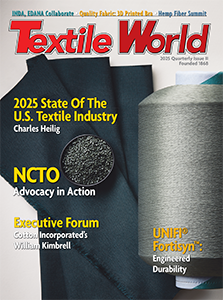“Despite some improvements in the recent past foreign matter, stickiness and seed-coat fragments in
raw cotton continue to be serious challenges to the cotton spinning industry worldwide.” This
sentence is kind of a general summary of the International Textile Manufacturers Federation’s
(ITMF’s) Cotton Contamination Survey for the year 2009.
Every Second Year
The Cotton Contamination Survey is produced by ITMF every other year. Last year’s edition is
the 11th issue in the series since a new methodology was applied in 1989. And the paper is very
much representative: 110 spinning mills located in 23 countries evaluated 63 different cotton
growths.
Following is ITMF’s summary of the survey:
Contamination — Unchanged In Comparison To 2007
The level of cottons modestly or seriously contaminated as perceived by the spinning mills
from around the world did not increase compared to the last survey in 2007 remaining constant at
22%. A closer look at the extent of the contamination shows that 6% (2007: 7%) of all cotton
evaluated were seriously contaminated by some sort of foreign matter whereas 16% (2007: 15%) were
only moderately contaminated. As the summary data are arithmetic averages of the different
contaminants, the extent of contamination is fully illustrated only by the results for the
individual contaminants. They range from 4% for “tar” (2007: 5%) to 42% of all cottons processed
being contaminated by “organic matter”, i.e. leaves, feathers, paper, leather, etc. (2007: 40%).
Other serious contaminants are “strings made of jute hessian” (32%), “strings made of woven
plastic” (29%), “fabrics made of cotton” as well as “fabrics made of plastic film” and “strings
made of cotton” (26% each). The most contaminated cotton descriptions considered for the survey
originated in India, Pakistan, Egypt, Uzbekistan and Mali. In contrast, very clean raw cottons were
produced in the USA, (Texas High Plains, Memphis, Pima, South Eastern, California), Israel,
Australia, Brazil and the Ivory Coast.
Stickiness — Record Low
The presence of sticky cotton as perceived by the spinning mills fell in 2009 to 16%, the
lowest level ever recorded (compared to 21% in 2007). Nevertheless, the level of stickiness is
still considerable high and remains a major challenge to the spinning industry. Descriptions that
were affected most by stickiness were those from Burkina Faso, Benin, Brazil, Chad, and Uzbekistan
(medium staples). Also US cotton growths like US-Pima, Israel-Pima, Mali or Tajikistan (medium
staples) were reported to be sticky. On the other end of the range, cottons from Egypt, Greece, USA
(California, South Eastern), Australia, Ivory Coast, Nigeria, and Pakistan (AmSeed AFZAL, Others)
or India (Shankar-4/6, MCU-5) were not or hardly affected by stickiness.
Seed-coat Fragments — Lowest Level Recorded Since Introdution In 1991
With regard to seed-coat fragments the Cotton Contamination Survey 2009 shows that their
appearance in cotton growths remained an issue for spinners around the world with 31% claiming that
they have encountered them in the cotton growths consumed. This is the lowest level since including
measuring the level of seed-coat fragments in the survey in 1991. The origins affected most by
seed-coat fragments are those from Nigeria, India (H-4, J-34), USA (South Eastern), Uzbekistan
(medium staples), Tajikistan (medium staples), Burkina Faso and Syria. Cotton descriptions for
which the existence of seed-coat fragments was negligible (prevalence of less than 20%) included
those from Australia, Benin, India (Others), Pakistan (Others), and the US (California, Texas High
Plains).
May 4, 2010




